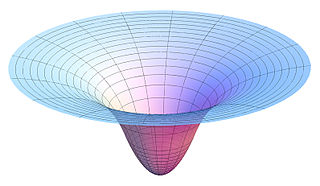
In physics, a force is an influence that causes the motion of an object with mass to change its velocity, i.e., to accelerate. It can be a push or a pull, always with magnitude and direction, making it a vector quantity. It is measured in the SI unit of newton (N) and represented by the symbol F.

Mass is an intrinsic property of a body. It was traditionally believed to be related to the quantity of matter in a physical body, until the discovery of the atom and particle physics. It was found that different atoms and different elementary particles, theoretically with the same amount of matter, have nonetheless different masses. Mass in modern physics has multiple definitions which are conceptually distinct, but physically equivalent. Mass can be experimentally defined as a measure of the body's inertia, meaning the resistance to acceleration when a net force is applied. The object's mass also determines the strength of its gravitational attraction to other bodies.

In physics, potential energy is the energy held by an object because of its position relative to other objects, stresses within itself, its electric charge, or other factors. The term potential energy was introduced by the 19th-century Scottish engineer and physicist William Rankine, although it has links to the ancient Greek philosopher Aristotle's concept of potentiality.

In celestial mechanics, escape velocity or escape speed is the minimum speed needed for a free, non-propelled object to escape from the gravitational influence of a primary body, thus reaching an infinite distance from it. It is typically stated as an ideal speed, ignoring atmospheric friction. Although the term "escape velocity" is common, it is more accurately described as a speed than a velocity because it is independent of direction. The escape speed is independent of the mass of the escaping object, but increases with the mass of the primary body; it decreases with the distance from the primary body, thus taking into account how far the object has already traveled. Its calculation at a given distance means that no acceleration is further needed for the object to escape: it will slow down as it travels—due to the massive body's gravity—but it will never quite slow to a stop. On the other hand, an object already at escape speed needs slowing for it to be captured by the gravitational influence of the body.
In physics, a gravitational field is a model used to explain the influences that a massive body extends into the space around itself, producing a force on another massive body. Thus, a gravitational field is used to explain gravitational phenomena, and is measured in newtons per kilogram (N/kg). Equivalently, it is measured in meters per second squared (m/s2).

Poisson's equation is an elliptic partial differential equation of broad utility in theoretical physics. For example, the solution to Poisson's equation is the potential field caused by a given electric charge or mass density distribution; with the potential field known, one can then calculate electrostatic or gravitational (force) field. It is a generalization of Laplace's equation, which is also frequently seen in physics. The equation is named after French mathematician and physicist Siméon Denis Poisson.
In physics, chemistry and biology, a potential gradient is the local rate of change of the potential with respect to displacement, i.e. spatial derivative, or gradient. This quantity frequently occurs in equations of physical processes because it leads to some form of flux.

In classical mechanics, the gravitational potential at a point in space is equal to the work per unit mass that would be needed to move an object to that point from a fixed reference point. It is analogous to the electric potential with mass playing the role of charge. The reference point, where the potential is zero, is by convention infinitely far away from any mass, resulting in a negative potential at any finite distance.

In the theory of general relativity, the equivalence principle is the equivalence of gravitational and inertial mass, and Albert Einstein's observation that the gravitational "force" as experienced locally while standing on a massive body is the same as the pseudo-force experienced by an observer in a non-inertial (accelerated) frame of reference.

Trip distribution is the second component in the traditional four-step transportation forecasting model. This step matches tripmakers’ origins and destinations to develop a “trip table”, a matrix that displays the number of trips going from each origin to each destination. Historically, this component has been the least developed component of the transportation planning model.
A classical field theory is a physical theory that predicts how one or more physical fields interact with matter through field equations, without considering effects of quantization; theories that incorporate quantum mechanics are called quantum field theories. In most contexts, 'classical field theory' is specifically intended to describe electromagnetism and gravitation, two of the fundamental forces of nature.

Hydraulic head or piezometric head is a specific measurement of liquid pressure above a vertical datum.
In economics, Reilly's law of retail gravitation is a heuristic developed by William J. Reilly in 1931. According to Reilly's "law," customers are willing to travel longer distances to larger retail centers given the higher attraction they present to customers. In Reilly's formulation, the attractiveness of the retail center becomes the analogy for size (mass) in the physical law of gravity.
In mathematical physics and differential geometry, a gravitational instanton is a four-dimensional complete Riemannian manifold satisfying the vacuum Einstein equations. They are so named because they are analogues in quantum theories of gravity of instantons in Yang–Mills theory. In accordance with this analogy with self-dual Yang–Mills instantons, gravitational instantons are usually assumed to look like four dimensional Euclidean space at large distances, and to have a self-dual Riemann tensor. Mathematically, this means that they are asymptotically locally Euclidean hyperkähler 4-manifolds, and in this sense, they are special examples of Einstein manifolds. From a physical point of view, a gravitational instanton is a non-singular solution of the vacuum Einstein equations with positive-definite, as opposed to Lorentzian, metric.
In theoretical physics, a scalar–tensor theory is a field theory that includes both a scalar field and a tensor field to represent a certain interaction. For example, the Brans–Dicke theory of gravitation uses both a scalar field and a tensor field to mediate the gravitational interaction.
Scalar–tensor–vector gravity (STVG) is a modified theory of gravity developed by John Moffat, a researcher at the Perimeter Institute for Theoretical Physics in Waterloo, Ontario. The theory is also often referred to by the acronym MOG.
Alternatives to general relativity are physical theories that attempt to describe the phenomenon of gravitation in competition to Einstein's theory of general relativity. There have been many different attempts at constructing an ideal theory of gravity.

Entropic gravity, also known as emergent gravity, is a theory in modern physics that describes gravity as an entropic force—a force with macro-scale homogeneity but which is subject to quantum-level disorder—and not a fundamental interaction. The theory, based on string theory, black hole physics, and quantum information theory, describes gravity as an emergent phenomenon that springs from the quantum entanglement of small bits of spacetime information. As such, entropic gravity is said to abide by the second law of thermodynamics under which the entropy of a physical system tends to increase over time.
In particle physics and physical cosmology, Planck units are a set of units of measurement defined exclusively in terms of four universal physical constants, in such a manner that these physical constants take on the numerical value of 1 when expressed in terms of these units. Originally proposed in 1899 by German physicist Max Planck, these units are a system of natural units because their definition is based on properties of nature, more specifically the properties of free space, rather than a choice of prototype object. They are relevant in research on unified theories such as quantum gravity.
Bimetric gravity or bigravity refers to two different classes of theories. The first class of theories relies on modified mathematical theories of gravity in which two metric tensors are used instead of one. The second metric may be introduced at high energies, with the implication that the speed of light could be energy-dependent, enabling models with a variable speed of light.
























